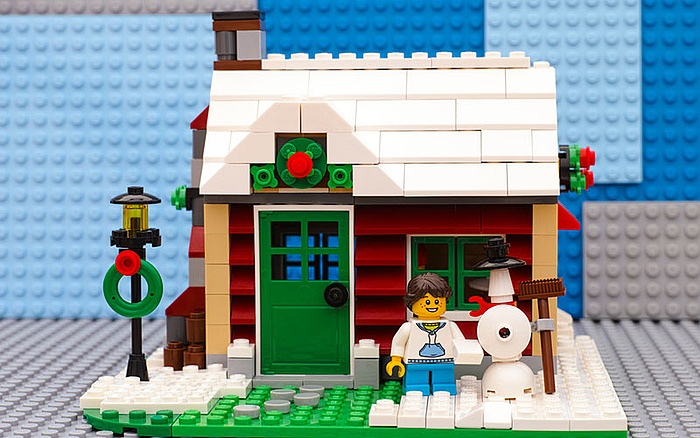
Everyday IP: The building blocks of LEGO law
International LEGO Day may sound like a holiday for playing with toys, but January 28's unofficial celebration also represents something far more serious: a global appreciation for the protections conferred by patents and other Intellectual Property (IP) rights.
On January 28, 1958, Godtfred Kirk Christiansen submitted a patent that would change building blocks forever. Thanks to this action and a ton of creativity, LEGO went on to become an international name, leveraging the IP system to grow far beyond the toybox. International LEGO Day is the perfect chance to reflect on this monumental growth, the patents that made it all possible and the laws that empower some of the world's most memorable inventions.
A star-studded patent
The LEGO Group, founded in 1932 in Denmark by Ole Kirk Kristiansen, originally made toys from polished beechwood. As it grew into its name — an abbreviation of the Danish words "leg godt," or "play well" — the company moved toward the production of plastic bricks. Eventually, in 1958, Godtfred Kirk Christiansen, the founder's son, protected these tiny titans of toymaking with the first LEGO brick patent.
If he had submitted this patent today, Godtfred Kirk Christiansen (who legally changed the spelling of his family name) would no doubt have had an easier time securing protection across multiple European countries at once or even internationally, thanks to the Patent Cooperation Treaty (PCT) and other agreements. At the time, however, patent filing had few of the consolidated processes enjoyed in 2024, such as the Unitary Patent from the European Patent Office (EPO), so LEGO products were protected by a web of patents across nations. Each grant tells a part of the LEGO story that is often far from the minds of everyday consumers. Without exclusive rights in Denmark and major export markets, the unique interlocking design and internal tubes that make each brick immediately recognizable could have been snatched up by imitators.
Trademarks, designs and more
As patent protections in different countries began to expire, the LEGO team looked to trademark law to ensure the brand's market position. However, the outcome was less than ideal. For instance, in 2010, the European Court of Justice ruled that LEGO bricks were ineligible for trademark protection in and of themselves, upholding a decision by the Grand Board of Appeal that the Lego brick's features performed a utilitarian function and were not adopted for the purpose of identification. This meant that trademark law could not protect those elements of LEGO products.

Though kits include instructions on how to build specific models, much of the appeal of the colored bricks stems from the creative freedom they afford. Just six eight-studded pieces can be combined in 915,103,765 ways. (Image source: iStock. Credit: Ekaterina79)
Nonetheless, LEGO persisted, finding new ways to protect its IP. In a surprising twist of events, 11 years after being denied trademark protection, the company prevailed before the General Court of the European Union in obtaining design rights for its iconic bricks. With this win, LEGO has the opportunity to benefit from up to 25 years of registered protection. Over the years, it has leveraged a combination of copyright, trademark, design and trade secret laws to maintain control over its products. These efforts have expanded with the company, showing that IP protection and product creativity are often two sides of the same coin.
New products, new patents
Despite occasional struggles in courtrooms, the LEGO Group saw unquestionable success in playrooms. The company sought to capitalize on earlier achievements by introducing new products compatible with all prior versions — a goal that eventually led to additional releases, including the now-iconic LEGO Minifigure. Launched in 1978, the figure was an improvement over the original LEGO building figure in that it had movable legs that could connect to standard bricks in standing and sitting positions.
Another innovation in LEGO's history is LEGO DUPLO. Derived from the Latin word for "double," these 2:1 scale bricks were designed for younger children and patented in 1967. They were soon followed by DUPLO figures, which are similar to Minifigures in design but rounder and better suited for younger children.
In time, the company established LEGO DUPLO as a sub-brand with a distinctive rabbit logo. This approach shifted slightly when the LEGO group partnered with child development experts to align with toddlers' mental and emotional growth more closely. The result was the LEGO Explore range in 2002 — interchangeable with DUPLO bricks but without the name and logo. Unfortunately, the switch confused consumers, many of whom would have been familiar with the DUPLO name from their own childhoods. This forced LEGO to attempt to clarify the compatibility before finally reverting to the older branding.

The much larger design of DUPLO blocks opens up play opportunities to younger children, whose motor skills are less developed while removing the choking hazard presented by small pieces. (Image source: iStock. Credit: Kostikova)
The DUPLO tale serves as a reminder that to be fully successful, inventors and companies must build upon their foundational patents and turn them into stories through packaging, messaging, branding and more.
LEGO partnerships and legal protections
As LEGO continued to explore new markets, so too did its ambitions extend. In June 1968, the first LEGOLAND amusement park opened in Billund, Denmark. Over the decades that followed, 11 more parks would open across the world, with another four on the way. For all of these accomplishments, arguably one of its most fruitful endeavors has been its partnerships with other IP owners to create officially licensed merchandise for the world's favorite franchises.
In 1999, media company Lucasfilm Ltd. popped the cork on a deal with the LEGO Group, making "Star Wars" the first entertainment property to partner with the LEGO brand. At the time, however, licensing gossip was focused on Lucasfilm, not a then-struggling LEGO.
Witnessing a reversal of its stagnating fortunes, LEGO has since expanded its partnerships to include IP from many other well-known brands and franchises, such as "Harry Potter" and "Marvel." Product offerings have gone far beyond licensed building sets and Minifigures; LEGO is now a prominent player in the animation and video game scenes, too.

The original Billund venue was the only Legoland park in the world for almost 28 years until the Windsor location opened in March 1996. Though no longer the most popular, the first park still draws in more than a million visitors each year. (Image source: iStock. Credit: Remus Kotsell)
A combination of both unique ideas and a passion for patents have led the company to expand in unexpected directions. This inspires a fascinating line of thought: Was it creativity or legal need that drove the LEGO Group to develop as far as it has? Whatever the answer, the point remains that IP protections are far more than rules and regulations; they are a vehicle — and often a catalyst — for invention and innovation.
The Dennemeyer consultants and legal experts can help you construct a wall of IP rights to surround your valuable assets or bring a fresh point of view to unleash your creativity. Contact us to learn more about our full range of IP software and solutions.
Filed in

IP infringement disputes abound in the film industry but some are more dramatic than others. Explore the unusual IP cases spawned from prominent movies.



